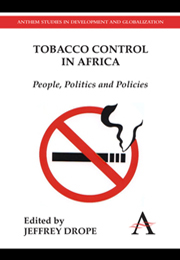Book contents
- Frontmatter
- Contents
- List of Figures and Tables
- Foreword
- Preface
- Acknowledgments
- List of Abbreviations and Acronyms
- 1 Introduction
- 2 The Political Mapping Process
- 3 Progress on Smoke-Free Policies
- 4 Taxation as a Tobacco Control Strategy
- 5 The Challenges of Implementing Bans on Advertising, Promotion and Sponsorship
- 6 The Pursuit of Packaging and Labeling Requirements
- 7 Burkina Faso
- 8 Cameroon
- 9 Eritrea
- 10 Ghana
- 11 Kenya
- 12 Malawi
- 13 Mauritius
- 14 Nigeria
- 15 Senegal
- 16 South Africa
- 17 Tanzania
- 18 Zambia
- 19 Conclusion: Tobacco Control in Africa – People, Politics and Policies
- Notes on Contributors
- Index
6 - The Pursuit of Packaging and Labeling Requirements
Published online by Cambridge University Press: 05 March 2012
- Frontmatter
- Contents
- List of Figures and Tables
- Foreword
- Preface
- Acknowledgments
- List of Abbreviations and Acronyms
- 1 Introduction
- 2 The Political Mapping Process
- 3 Progress on Smoke-Free Policies
- 4 Taxation as a Tobacco Control Strategy
- 5 The Challenges of Implementing Bans on Advertising, Promotion and Sponsorship
- 6 The Pursuit of Packaging and Labeling Requirements
- 7 Burkina Faso
- 8 Cameroon
- 9 Eritrea
- 10 Ghana
- 11 Kenya
- 12 Malawi
- 13 Mauritius
- 14 Nigeria
- 15 Senegal
- 16 South Africa
- 17 Tanzania
- 18 Zambia
- 19 Conclusion: Tobacco Control in Africa – People, Politics and Policies
- Notes on Contributors
- Index
Summary
According to the FCTC “Guidelines for the Implementation of Article 11,” well-designed health warnings and messages are an important part of a range of effective measures to communicate health risks and to reduce tobacco use. Research evidence demonstrates that the effectiveness of health warnings and messages increases with their prominence. In comparison with small, text-only health warnings, larger warnings with pictures are more likely to be noticed, better communicate health risks, provoke a greater emotional response and increase the motivation of tobacco users to quit or to decrease their tobacco consumption. Larger picture warnings are also more likely to retain their effectiveness over time and are particularly effective in communicating health effects to low-literacy populations, children and young people. Other elements that enhance effectiveness include locating health warnings and messages at the top of the principal display areas; the use of color rather than just black and white; requiring that multiple health warnings rotate and appear concurrently; and periodic revision of health warnings and messages.
One of the particularly compelling possibilities with packaging and labeling restrictions is that it is not always necessary to address this issue using national legislation, though it certainly can be – and has been – done this way. In countries that are struggling with the passing of new legislation, this less burdensome option offers many possibilities. In fact, as this chapter demonstrates, many countries allow regulatory agencies, often but not always in health ministries, to handle many and even most issues regarding packaging and labeling.
- Type
- Chapter
- Information
- Tobacco Control in AfricaPeople, Politics and Policies, pp. 79 - 96Publisher: Anthem PressPrint publication year: 2011

